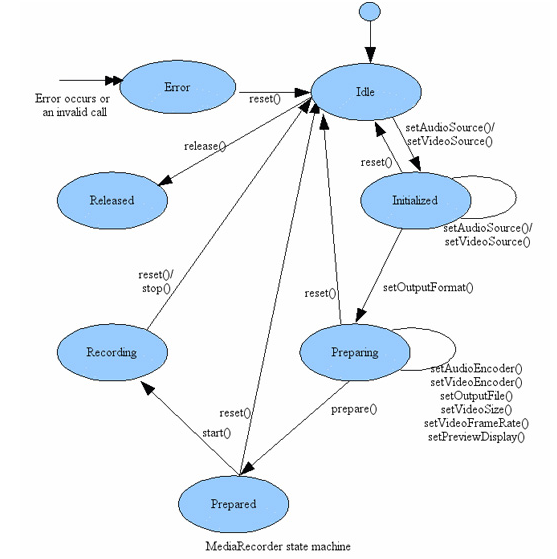SoundPool
SoundPool类管理和播放音频资源的应用。因为MediaPlayer在播放音乐时会资源占用量较高、延迟时间较长、不支持多个音频同时播放等。,但有时一些系统提示音很小,就没有必要用MediaPlayer去播放,就用到了SoundPool.SoundPool载入音乐文件使用了独立的线程,不会阻塞UI主线程的操作。SoundPool主要用于播放一些较短的声音片段,与MediaPlayer相比,SoundPool的优势在于CPU资源占用量低和反应延迟小。另外,SoundPool还支持自行设置声音的品质、音量、 播放比率等参数。
SoundPlayer 播放音频的实现步骤
activity_main.xml
<LinearLayout xmlns:android="http://schemas.android.com/apk/res/android"
xmlns:tools="http://schemas.android.com/tools" android:layout_width="match_parent"
android:layout_height="match_parent"
android:orientation="vertical"
tools:context=".MainActivity">
<Button
android:id="@+id/btn_soundpool"
android:layout_width="wrap_content"
android:layout_height="wrap_content"
android:text="提示音"/>
</LinearLayout>MainActivity.java
public class MainActivity extends AppCompatActivity {
private Button btn_soundpool;
private SoundPool pool=null;
private int voiceID;
@Override
protected void onCreate(Bundle savedInstanceState) {
super.onCreate(savedInstanceState);
setContentView(R.layout.activity_main);
voiceID=initSoundpool();
btn_soundpool= (Button) findViewById(R.id.btn_soundpool);
btn_soundpool.setOnClickListener(new View.OnClickListener() {
@Override
public void onClick(View v) {
playSound();
}
});
}
public void playSound(){
//play(int soundID, float leftVolume, float rightVolume, int priority, int loop, float rate) ,
// soundID该方法的第一个参数指定播放哪个声音,其中leftVolume和rightVolume表示左右音量,
// priority表示优先级,loop表示循环次数,rate表示速率,如
//速率最低0.5最高为2,1代表正常速度
pool.play(voiceID,1,1,0,1,1);
}
private int initSoundpool() {
//判断sdk的版本号,高于21 的可以用下面的方法
if (Build.VERSION.SDK_INT >= 21) {
//通过SoundPool.Builder创建SoundPool得到实例对象
SoundPool.Builder builder=new SoundPool.Builder();
//setMaxStreams()方法设置可以同时播放的同时流的最大数量。参数为大于等于1的值
builder.setMaxStreams(2);
//AudioAttributes类封装的属性的集合来描述一个音频流的信息。
//AudioAttributes.Builder用于生成AudioAttributes类
AudioAttributes.Builder attrBuilder=new AudioAttributes.Builder();
//AudioAttributes.Builder的setLegacyStreamType()方法从传统的流类型中推断出的属性。
//setLegacyStreamType参数AudioManager.STREAM_MUSIC为音乐播放的音频流
attrBuilder.setLegacyStreamType(AudioManager.STREAM_MUSIC);
//setAudioAttributes()方法得到AudioAttributes集合,参数为attribute类型的非空值
builder.setAudioAttributes(attrBuilder.build());
pool=builder.build();
}else{
//SDK版本低于21的可以用下面的方法
//第一个参数是声音的大小,第二个参数是数量流的类型,第三个参数为采样率转化质量,当前无效果,使用0作为默认值
pool=new SoundPool(2,AudioManager.STREAM_MUSIC,0);
}
//int load(String path, int priority) 从APK资源载入或 resld 所对应的资源加载声音。
//最后一个参数为优先级。
//加载声音之后,该方法都会返回该声音的的ID,以后程序就可以通过该声音的ID 来播放指定声音。
return pool.load(getApplicationContext(),R.raw.msg,1);
}
}MediaRecorder录音
MediaRecorder的机制图,录音需要系统的录音权限
<uses-permission android:name="android.permission.RECORD_AUDIO"></uses-permission>
<uses-permission android:name="android.permission.WRITE_EXTERNAL_STORAGE"></uses-permission>
基本的步骤为:
1、创建一个实例对象
2、创建一个Mediarecorder的类,然后调用Mediarecorder的方法完成设置audio源、设置输出文件格式、audio编码格式、设置输出文件
3、准备录音,开始录音,停止录音,释放相关连接对象
>
mediaRecorder=new MediaRecorder();
mediaRecorder.setAudioSource(MediaRecorder.AudioSource.MIC);
mediaRecorder.setOutputFormat(MediaRecorder.OutputFormat.THREE_GPP);
mediaRecorder.setAudioEncoder(MediaRecorder.AudioEncoder.AMR_NB);
mediaRecorder.setOutputFile(Environment.getExternalStorageDirectory()+"/myrecord.3gp");
mediaRecorder.prepare();
mediaRecorder.start();
mediaRecorder.stop();
//reset()重启mediarecorder其空闲状态
mediaRecorder.reset();
//release()释放资源这个mediarecorder对象关联
mediaRecorder.release();activity_main.xml
public class MainActivity extends AppCompatActivity implements View.OnClickListener{
private Button btn_StartRecorder;
private Button btn_StopRecorder;
private MediaRecorder mediaRecorder;
@Override
protected void onCreate(Bundle savedInstanceState) {
super.onCreate(savedInstanceState);
setContentView(R.layout.activity_main);
voiceID=initSoundpool();
btn_StartRecorder= (Button) findViewById(R.id.btn_start_recorder);
btn_StartRecorder.setOnClickListener(this);
btn_StopRecorder= (Button) findViewById(R.id.btn_stop_recorder);
btn_StopRecorder.setOnClickListener(this);
}
@Override
public void onClick(View v) {
switch(v.getId()){
case R.id.btn_start_recorder:
//创建一个MediaRecorder类的实例对象
mediaRecorder=new MediaRecorder();
//setAudioSource()方法设置用于录制的音频源,参数为使用的音频源
//MediaRecorder.AudioSource定义的音频源.MIC为麦克风音频源
mediaRecorder.setAudioSource(MediaRecorder.AudioSource.MIC);
//setOutputFormat()方法为设置输出格式为.3gp
mediaRecorder.setOutputFormat(MediaRecorder.OutputFormat.THREE_GPP);
//setAudioEncoder()方法为设置编码格式,
// 参数为定义的音频编码格式,AMR_NB为AMR(窄带)音频编解码器
mediaRecorder.setAudioEncoder(MediaRecorder.AudioEncoder.AMR_NB);
//setOutputFile()方法设置输出文件的路径,
mediaRecorder.setOutputFile(Environment.getExternalStorageDirectory()+"/myrecord.3gp");
try {
//prepare()准备录音机开始捕获和编码数据。
mediaRecorder.prepare();
//start()开始捕获和指定setoutputfile()文件数据编码
mediaRecorder.start();
} catch (IOException e) {
e.printStackTrace();
}
break;
case R.id.btn_stop_recorder:
//stop()停止录制
mediaRecorder.stop();
//reset()重启mediarecorder其空闲状态
mediaRecorder.reset();
//release()释放资源这个mediarecorder对象关联
mediaRecorder.release();
break;
}
}
}activity_main.xml
<LinearLayout xmlns:android="http://schemas.android.com/apk/res/android"
xmlns:tools="http://schemas.android.com/tools" android:layout_width="match_parent"
android:layout_height="match_parent"
android:orientation="vertical"
tools:context=".MainActivity">
<Button
android:id="@+id/btn_start_recorder"
android:layout_width="wrap_content"
android:layout_height="wrap_content"
android:text="开始录音"/>
<Button
android:id="@+id/btn_stop_recorder"
android:layout_width="wrap_content"
android:layout_height="wrap_content"
android:text="结束录音"/>
</LinearLayout>AndroidManifest.xml
<?xml version="1.0" encoding="utf-8"?>
<manifest xmlns:android="http://schemas.android.com/apk/res/android"
package="com.example.administrator.soundpool" >
<uses-permission android:name="android.permission.RECORD_AUDIO"></uses-permission>
<uses-permission android:name="android.permission.WRITE_EXTERNAL_STORAGE"></uses-permission>
<uses-permission android:name="android.permission.READ_EXTERNAL_STORAGE"></uses-permission>
<application
android:allowBackup="true"
android:icon="@mipmap/music"
android:label="@string/app_name"
android:theme="@style/AppTheme" >
<activity
android:name=".MainActivity"
android:label="@string/app_name" >
<intent-filter>
<action android:name="android.intent.action.MAIN" />
<category android:name="android.intent.category.LAUNCHER" />
</intent-filter>
</activity>
<activity android:name=".SurfaceViewActivity"></activity>
</application>
</manifest>VideoView和SurfaceView播放视频
用VideoView控件来播放视频,显示视频文件。VideoView类可以从各种来源加载图像(如资源或内容提供商),负责计算测量从视频,它可以用在任何布局管理器,提供了各种各样的显示选项,如缩放和着色。
SurfaceView和View最本质的区别在于,surfaceView是在一个新起的单独线程中可以重新绘制画面而View必须在UI的主线程中更新画面。 当使用surfaceView 由于是在新的线程中更新画面所以不会阻塞你的UI主线程。虽然VideoView可以很容易地播放视频,但播放位置和播放大小并不受控制,因此,需要用SurfaceView来播放视频
activity_main.xml
<LinearLayout xmlns:android="http://schemas.android.com/apk/res/android"
xmlns:tools="http://schemas.android.com/tools" android:layout_width="match_parent"
android:layout_height="match_parent"
android:orientation="vertical"
tools:context=".MainActivity">
<Button
android:id="@+id/btn_surfaceview"
android:layout_width="wrap_content"
android:layout_height="wrap_content"
android:text="开始播放surfacview"/>
<Button
android:id="@+id/btn_start_playvideo"
android:layout_width="wrap_content"
android:layout_height="wrap_content"
android:text="开始播放"/>
<VideoView
android:id="@+id/videoview"
android:layout_width="wrap_content"
android:layout_height="wrap_content" />
</LinearLayout>AndroidManifest.xml
<?xml version="1.0" encoding="utf-8"?>
<manifest xmlns:android="http://schemas.android.com/apk/res/android"
package="com.example.administrator.soundpool" >
<uses-permission android:name="android.permission.RECORD_AUDIO"></uses-permission>
<uses-permission android:name="android.permission.WRITE_EXTERNAL_STORAGE"></uses-permission>
<uses-permission android:name="android.permission.READ_EXTERNAL_STORAGE"></uses-permission>
<application
android:allowBackup="true"
android:icon="@mipmap/music"
android:label="@string/app_name"
android:theme="@style/AppTheme" >
<activity
android:name=".MainActivity"
android:label="@string/app_name" >
<intent-filter>
<action android:name="android.intent.action.MAIN" />
<category android:name="android.intent.category.LAUNCHER" />
</intent-filter>
</activity>
<activity android:name=".SurfaceViewActivity"></activity>
</application>
</manifest>
MainActivity.java
public class MainActivity extends AppCompatActivity implements View.OnClickListener{
private Button btn_StartPlay;
private VideoView mVideoView;
private Button btn_surfaceview;
@Override
protected void onCreate(Bundle savedInstanceState) {
super.onCreate(savedInstanceState);
setContentView(R.layout.activity_main);
btn_StartPlay= (Button) findViewById(R.id.btn_start_playvideo);
btn_StartPlay.setOnClickListener(this);
mVideoView= (VideoView) findViewById(R.id.videoview);
btn_surfaceview= (Button) findViewById(R.id.btn_surfaceview);
btn_surfaceview.setOnClickListener(this);
}
@Override
public void onClick(View v) {
switch(v.getId()){
case R.id.btn_start_playvideo:
//setVideoPath设置视频的文件来源位置
mVideoView.setVideoPath(Environment.getExternalStorageDirectory()+"/aa.mp4");
//setMediaController设置进度条在界面上显示
mVideoView.setMediaController(new MediaController(MainActivity.this));
//start()开始播放视频
mVideoView.start();
break;
case R.id.btn_surfaceview:
Intent intent=new Intent(MainActivity.this,SurfaceViewActivity.class);
startActivity(intent);
break;
}
}
}SurfaceViewActivity.java启动另一个界面来说明surfaceView播放视频
public class SurfaceViewActivity extends Activity implements View.OnClickListener{
private Button btn_playsvvideo;
private SurfaceView mSurfaceView;
private MediaPlayer player;
@Override
protected void onCreate(Bundle savedInstanceState) {
super.onCreate(savedInstanceState);
setContentView(R.layout.activity_surfaceview);
btn_playsvvideo= (Button) findViewById(R.id.btn_playsurfaceview);
btn_playsvvideo.setOnClickListener(this);
mSurfaceView= (SurfaceView) findViewById(R.id.surfaceview);
}
@Override
public void onClick(View v) {
switch (v.getId()){
case R.id.btn_playsurfaceview:
if (player==null){
player=new MediaPlayer();
}
player.reset();
try {
//设置视频位置
player.setDataSource(Environment.getExternalStorageDirectory()+"/aa.mp4");
player.setAudioStreamType(AudioManager.STREAM_MUSIC);//设置声音类型
Log.d("空指针",player+""+mSurfaceView);
player.setDisplay(mSurfaceView.getHolder());//设置视频播放位置
player.prepare();//准备
player.setOnPreparedListener(new MediaPlayer.OnPreparedListener() {
@Override
public void onPrepared(MediaPlayer mp) {
mp.start();//开始播放
}
});
} catch (IOException e) {
e.printStackTrace();
}
break;
}
}
}activity_surfaceview.xml
<?xml version="1.0" encoding="utf-8"?>
<LinearLayout xmlns:android="http://schemas.android.com/apk/res/android"
android:orientation="vertical" android:layout_width="match_parent"
android:layout_height="match_parent">
<Button
android:id="@+id/btn_playsurfaceview"
android:layout_width="wrap_content"
android:layout_height="wrap_content"
android:text="开始播放"/>
<SurfaceView
android:id="@+id/surfaceview"
android:layout_width="wrap_content"
android:layout_height="wrap_content" />
</LinearLayout>调用系统摄像头
调用系统的摄像头进行拍照并显示在ImageView上,还可以调用系统的相册,选取其中的一张在ImageView上显示,有时候照片质量过高,无法显示,可以对照片进行压缩,在进行存储并显示。
MainActivity.xml(这里将图片压缩写到另一个类里)
public class MainActivity extends AppCompatActivity implements View.OnClickListener{
private Button btn_StartCamera;
private Button btn_OpenGallery;
private ImageView mImageView;
private File file;
private int GET_PIC_FORM_GALLERY=0x24;
@Override
protected void onCreate(Bundle savedInstanceState) {
super.onCreate(savedInstanceState);
setContentView(R.layout.activity_main);
btn_StartCamera= (Button) findViewById(R.id.btn_startcamera);
btn_StartCamera.setOnClickListener(this);
mImageView= (ImageView) findViewById(R.id.imageview);
btn_OpenGallery= (Button) findViewById(R.id.btn_open_gallery);
btn_OpenGallery.setOnClickListener(this);
}
@Override
public void onClick(View v) {
switch(v.getId()){
case R.id.btn_startcamera:
Intent intent=new Intent();
intent.setAction(MediaStore.ACTION_IMAGE_CAPTURE);//隐式启动系统相机
file=new File(Environment.getExternalStorageDirectory(),System.currentTimeMillis()+".jpg");
try {
file.createNewFile();
} catch (IOException e) {
e.printStackTrace();
}
intent.putExtra(MediaStore.EXTRA_OUTPUT,Uri.fromFile(file));//告诉系统相机将照片保存的位置
startActivityForResult(intent, 0x23);//开始启动
break;
//调用系统相册按钮事件监听
case R.id.btn_open_gallery:
Intent intentOpenGallery=new Intent(Intent.ACTION_GET_CONTENT);
//得到intent的类型为图片
intentOpenGallery.setType("image/*");
startActivityForResult(intentOpenGallery, GET_PIC_FORM_GALLERY);
break;
}
}
@Override
protected void onActivityResult(int requestCode, int resultCode, Intent data) {
super.onActivityResult(requestCode, resultCode, data);
if (resultCode==RESULT_OK){
if (requestCode==0x23){
ImageZip.zipImage(file.getAbsolutePath());//压缩图片
mImageView.setImageURI(Uri.fromFile(file));//得到图片
}if (requestCode==GET_PIC_FORM_GALLERY){
//从系统相册中得到图片
Uri uri=data.getData();
mImageView.setImageURI(uri);
}
}
}
}ImageZip.java(压缩图片的方法)
public class ImageZip {
public static void zipImage(String savePath) {
BitmapFactory.Options options = new BitmapFactory.Options();
options.inJustDecodeBounds = true;
BitmapFactory.decodeFile(savePath, options);
options.inSampleSize = computeInitialSampleSize(options, 480, 480 * 960);
options.inJustDecodeBounds = false;
Bitmap bitmap = BitmapFactory.decodeFile(savePath, options);
try {
FileOutputStream fos = new FileOutputStream(savePath);
bitmap.compress(Bitmap.CompressFormat.JPEG, 90, fos);
fos.flush();
fos.close();
} catch (IOException e) {
e.printStackTrace();
}
bitmap.recycle();
bitmap = null;
System.gc();
}
public static int computeSampleSize(BitmapFactory.Options options,
int minSideLength, int maxNumOfPixels) {
int initialSize = computeInitialSampleSize(options, minSideLength,
maxNumOfPixels);
int roundedSize;
if (initialSize <= 8) {
roundedSize = 1;
while (roundedSize < initialSize) {
roundedSize <<= 1;
}
} else {
roundedSize = (initialSize + 7) / 8 * 8;
}
return roundedSize;
}
private static int computeInitialSampleSize(BitmapFactory.Options options,
int minSideLength, int maxNumOfPixels) {
double w = options.outWidth;
double h = options.outHeight;
int lowerBound = (maxNumOfPixels == -1) ? 1 : (int) Math.ceil(Math
.sqrt(w * h / maxNumOfPixels));
int upperBound = (minSideLength == -1) ? 128 : (int) Math.min(
Math.floor(w / minSideLength), Math.floor(h / minSideLength));
if (upperBound < lowerBound) {
// return the larger one when there is no overlapping zone.
return lowerBound;
}
if ((maxNumOfPixels == -1) && (minSideLength == -1)) {
return 1;
} else if (minSideLength == -1) {
return lowerBound;
} else {
return upperBound;
}
}
}activity_main.xml
<RelativeLayout xmlns:android="http://schemas.android.com/apk/res/android"
xmlns:tools="http://schemas.android.com/tools" android:layout_width="match_parent"
android:layout_height="match_parent" android:paddingLeft="@dimen/activity_horizontal_margin"
android:paddingRight="@dimen/activity_horizontal_margin"
android:paddingTop="@dimen/activity_vertical_margin"
android:paddingBottom="@dimen/activity_vertical_margin" tools:context=".MainActivity">
<Button
android:id="@+id/btn_startcamera"
android:layout_width="wrap_content"
android:layout_height="wrap_content"
android:text="调用系统相机"/>
<Button
android:id="@+id/btn_open_gallery"
android:layout_width="wrap_content"
android:layout_height="wrap_content"
android:layout_alignParentRight="true"
android:text="打开相册"/>
<ImageView
android:id="@+id/imageview"
android:layout_width="match_parent"
android:layout_height="match_parent" />
</RelativeLayout>AndroidManifest.xml
<?xml version="1.0" encoding="utf-8"?>
<manifest xmlns:android="http://schemas.android.com/apk/res/android"
package="com.example.administrator.camera" >
<uses-permission android:name="android.permission.WRITE_EXTERNAL_STORAGE"></uses-permission>
<application
android:allowBackup="true"
android:icon="@mipmap/camera"
android:label="@string/app_name"
android:theme="@style/AppTheme" >
<activity
android:name=".MainActivity"
android:label="@string/app_name" >
<intent-filter>
<action android:name="android.intent.action.MAIN" />
<category android:name="android.intent.category.LAUNCHER" />
</intent-filter>
</activity>
</application>
</manifest>

























 642
642











 被折叠的 条评论
为什么被折叠?
被折叠的 条评论
为什么被折叠?








